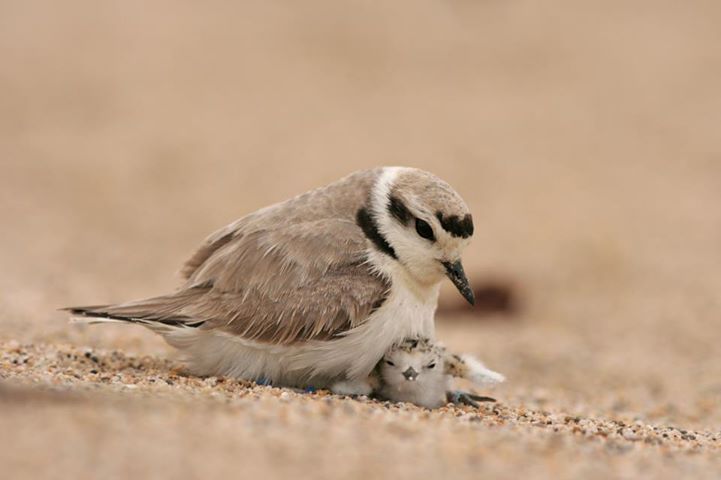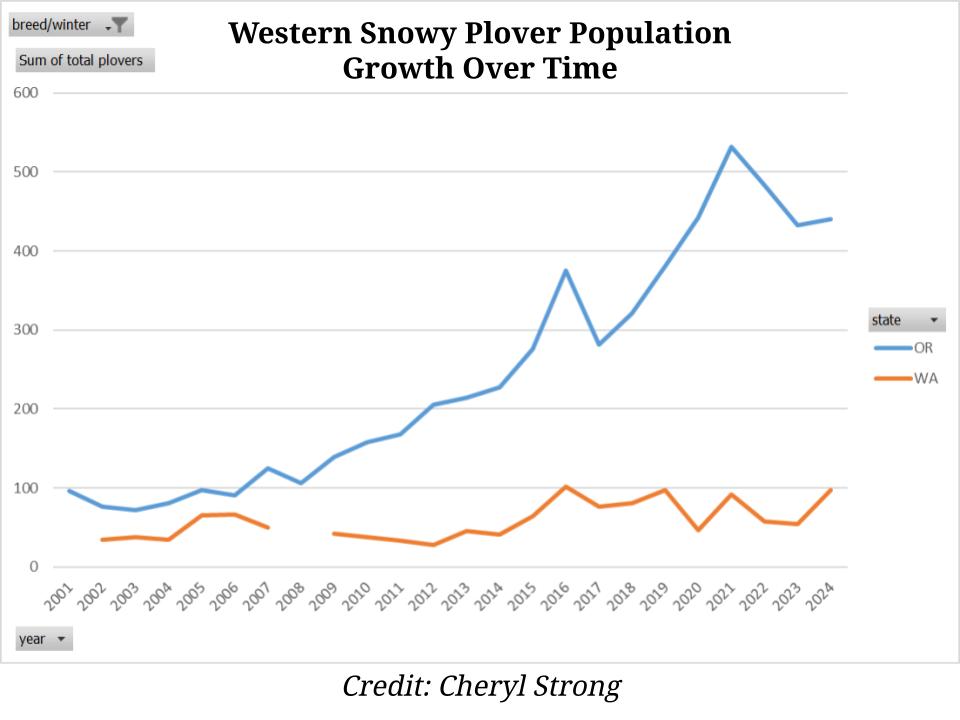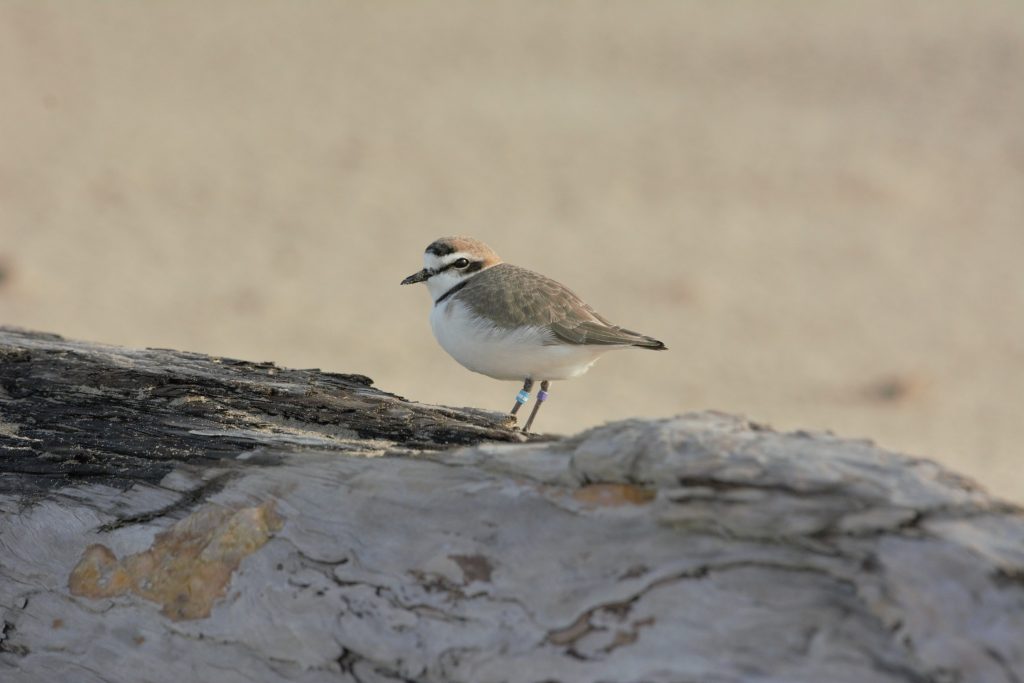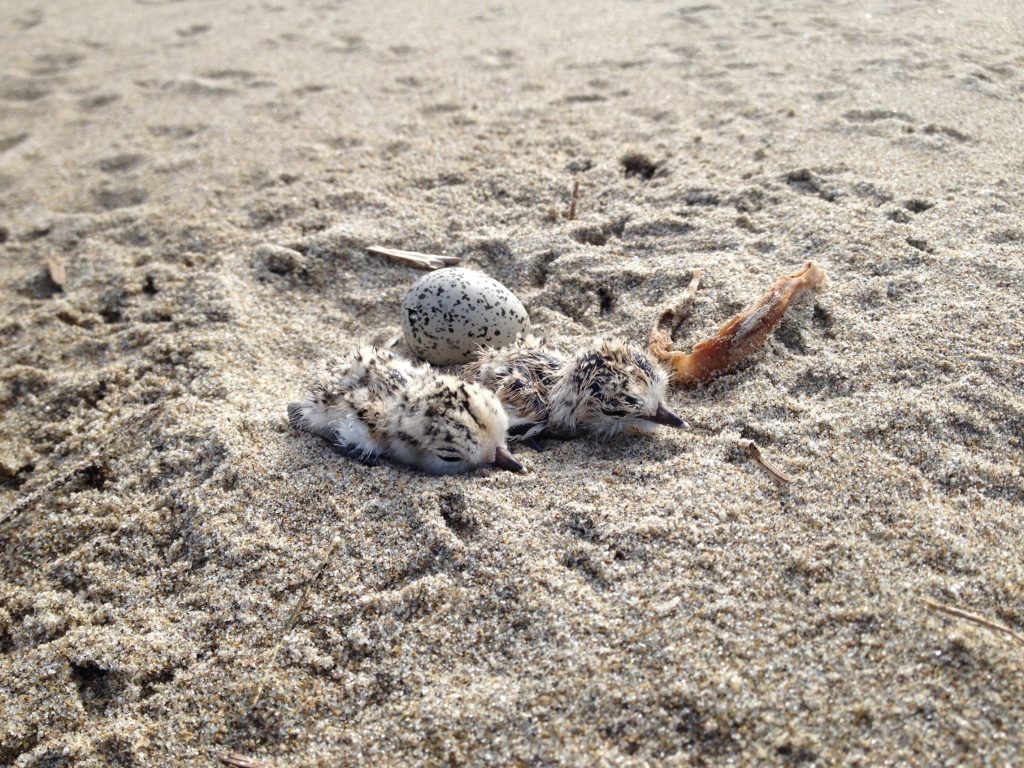April 16, 2025
Project Highlight: Western Snowy Plover Nest Monitoring and Protection
By Kylie Baker
A Conservation Success Story: Monitoring and Protecting Oregon’s Western Snowy Plover
Along the dynamic and windswept beaches of Oregon’s coast, a rare and resilient bird has made a remarkable comeback. The western snowy plover (Anarhynchus nivosus nivosus), once nearly extirpated from the region, is now at the center of one of the longest-running and most collaborative shorebird conservation efforts in the Pacific Northwest. While their population has grown, snowy plovers remain conservation-reliant—dependent on continued management and protection to persist in the face of ongoing threats. Thanks to the diligence of researchers and conservation partners, that support has remained steady.

This long-running initiative is part of a project¹ through the Pacific Northwest Cooperative Ecosystem Studies Unit. It has benefited from decades of leadership by Eleanor Gaines—formerly at Oregon State University and now continuing the work at Portland State University—and strong support from federal agencies including the Bureau of Land Management, U.S. Fish and Wildlife Service, U.S. Army Corps of Engineers, and the USDA Animal & Plant Health Inspection Service. In partnership with state agencies Oregon Department of Fish and Wildlife and Oregon Parks and Recreation Department, this coalition has spent over 30 years working together to safeguard vital plover habitat.

What began in 1990 as a modest initiative led by The Nature Conservancy has grown into a model of collaborative, science-based conservation. At the outset, Oregon’s western snowy plover population had dwindled to fewer than 50 individuals. Today, through intensive habitat restoration, coordinated recreation and predator management, and a unified approach across public lands, that number has grown to more than 700 birds—a testament to the strength of long-term partnerships and shared stewardship.
On-the-Ground Monitoring and Research
Field monitoring has been the cornerstone of this recovery effort. Each spring and summer, dedicated crews scour miles of shoreline, searching for the plover’s well-camouflaged nests. Once located, nests are monitored using mobile data collection tools, remote cameras, and field signs—like eggshell fragments or predator tracks—to assess nesting success. Color banding of some individuals enables tracking across their lifetimes, offering valuable insights into movement, survival, and site fidelity. Even in areas without banded plovers, the data collected in Oregon helps refine population estimates and survey methods regionally.

In addition to this localized monitoring, an essential part of the program is the coordinated “window surveys,” conducted each May and January across the snowy plover’s entire Pacific coast breeding range—from Washington to southern California. Conducted simultaneously by teams in multiple states, these surveys provide a critical snapshot of the population’s size and distribution during the peak of the breeding season and over winter. Because of their rigor and consistency, the long-term surveys are a key tool in understanding how the species is doing in Oregon and range-wide, allowing for comparisons across sites and over time.
Threats and Conservation Challenges
Despite these successes, snowy plovers continue to face a variety of threats. Predation from opportunistic species such as crows, ravens, and foxes—many of which thrive in human-altered environments—continues to take a toll. Meanwhile, invasive European beachgrass encroaches on the open dry sand habitat plovers need for nesting, making it harder to share shrinking beaches as recreational use rises.
To address these challenges, the Oregon Parks and Recreation Department developed a comprehensive, multi-agency Habitat Conservation Plan in 2007, followed by a U.S. Fish and Wildlife Service Recovery Plan the same year. These frameworks laid the groundwork for the creation of the Oregon snowy plover working group and an integrated predator management plan. This enables agencies to collaborate with Wildlife Services, a program within the Animal and Plant Health Inspection Service, to implement predator dissuasion and control in areas where snowy plovers have historically nested in strong numbers. These frameworks have created a rare level of coordination, enabling field crews and land managers across jurisdictions to implement shared strategies that protect nests and fledglings while balancing public access and recreation.

Adapting Strategies for a Thriving Population
As the snowy plover population has stabilized, the program has continued to adapt. For instance, while wire cage exclosures were once used to protect nests, they were found to increase risk to adult plovers by making them more visible to predators. Because adult survival plays a greater role in long-term population viability than individual nest success, exclosures have largely been phased out in favor of broader predator control efforts.
Managers have also adopted a flexible, regionally tailored approach. While some beaches—especially in the north—see lower reproductive success due to habitat limitations and high human use, they still contribute to the species’ range and resilience. Furthermore, not all beaches need to be equally productive; by designating certain areas specifically for western snowy plover habitat and others for recreation, land managers can strike a balance that supports both conservation and public enjoyment. Coastal community support has been instrumental, with many beachgoers embracing signage and stewardship guidelines, such as staying on wet sand in protected nesting areas and keeping dogs out of these areas. These efforts show that with awareness and intention, coexistence with these rare birds is possible.
The Value of Consistency
Perhaps the most extraordinary aspect of this conservation story is the consistency of its data collection and management over such a long period. In the world of wildlife conservation, it is uncommon for monitoring to be conducted so reliably and for so many years without interruption. Funding gaps, staff turnover, and shifting priorities often disrupt long-term projects, making it difficult to draw accurate conclusions. But in Oregon, the commitment of agency staff, researchers, and field crews has ensured a continuous stream of high-quality data since the early 1990s.
This long-term dataset is invaluable. It has not only helped conservationists fine-tune their approaches year by year but has also provided a foundation for understanding population dynamics, predator impacts, and habitat quality in a way that few other species benefit from. This has informed the predator management actions in real-time, and also informs habitat work and recreation management. The data from Oregon’s snowy plover program has become a resource for other regions and species, offering insight into what sustained, collaborative conservation can achieve.
A Model for Conservation Success
Oregon’s snowy plover recovery story offers a hopeful blueprint for conservation success. It illustrates the power of sustained partnerships, rigorous science, and community support in addressing complex conservation challenges. Perhaps most of all, it underscores the importance—and rarity—of long-term consistency in monitoring and management. That consistency has allowed researchers to respond to real-time trends, refine best practices, and advocate for effective, data-driven strategies that are now shaping shorebird conservation across the West. While continued management will be necessary to ensure the snowy plover’s future, the gains made over the last three decades show that with collaboration and persistence, recovery is possible—even for the most vulnerable of species.
¹This initiative has been supported as a PNW CESU project for several decades, operating under various project IDs over the years. These include: HAF033F06, L10AC20515, F12AC00483, F13AC00582, F14AC00547, F15AC00863, L15AC00045, F17AC00468, F18AC00463, F19AC00443, W9127N19R0026, 1240BK23P4000, 140L4318Q0074, 140L4323P0139, 140L4323Q0222, F21AC01210, F23AC00941, F24AC00935, and W9127N24P0029.
Key people who have contributed to this initiative include Cheryl Strong, the project lead at U.S. Fish and Wildlife Service; Jeff Stephens at the Bureau of Land Management; Laurel Hillmann at Oregon Parks and Recreation Department; and Cindy Burns at the U.S. Forest Service—though the Forest Service’s involvement, while longstanding, has not been through the CESU.
And special thanks to the many researchers, agency staff, field technicians, volunteers, and partners who have contributed to this effort over the past 30 years. Your dedication has been instrumental in supporting the resilience of Oregon’s western snowy plovers—and deeply appreciated.